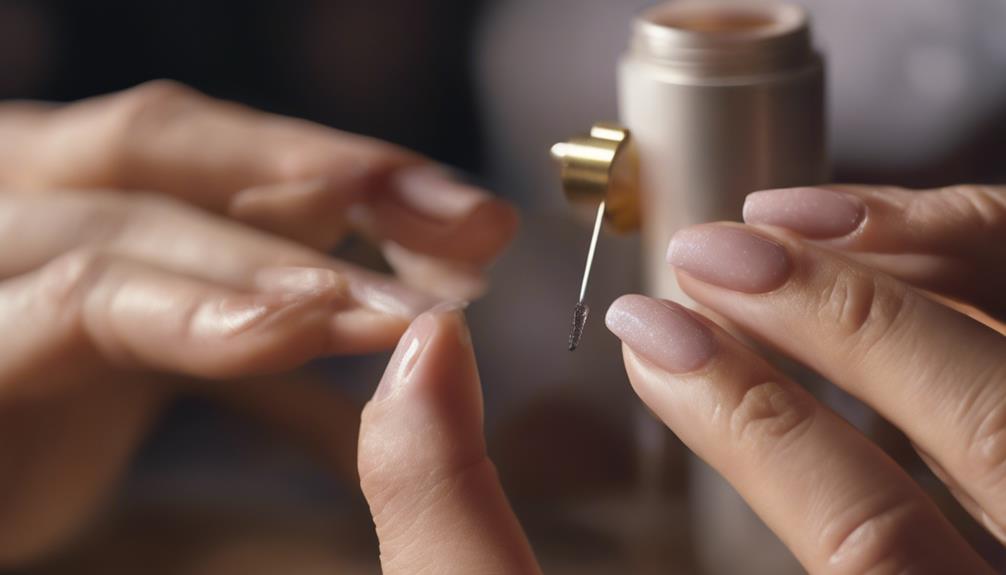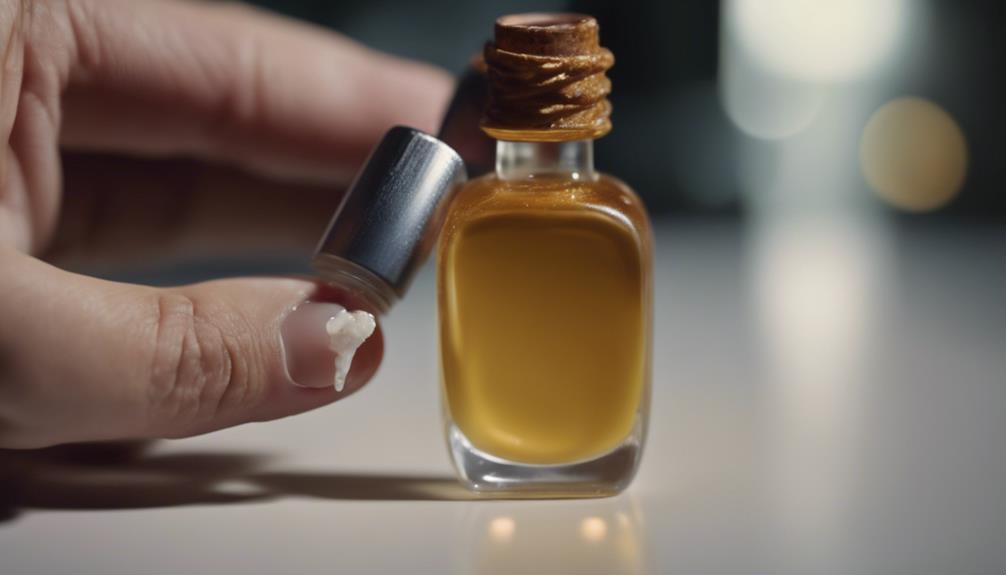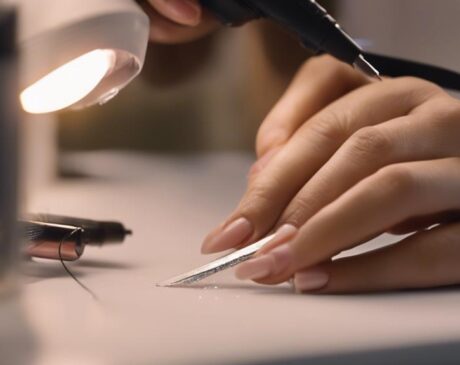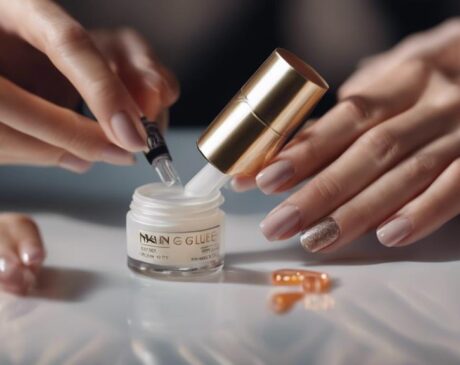Do You Put Nail Glue on Your Nail or the Fake Nail?

When applying nail glue, it is best to place it on the natural nail for effective adhesion. This method ensures a strong and lasting bond, preventing issues like air pockets or lifting. For flawless results, avoid solely applying glue on the fake nail. Find out more about proper nail glue application techniques and expert recommendations for long-lasting results.
Key Takeaways
- Apply nail glue to your natural nail for effective adhesion.
- Place the glue close to the cuticle but not touching it.
- Avoid solely applying glue on the fake nail for better results.
- Focus on the natural nail to ensure a strong and lasting bond.
- Precision in glue placement is key to flawless and durable nail application.
Pros and Cons of Applying on Natural Nail

Frequently, individuals debate the advantages and disadvantages of applying nail glue directly onto the natural nail surface. The primary benefit of applying nail glue on the natural nail is its ability to provide a strong bond that can last for an extended period. This method offers a more natural look, as the glue adheres directly to the nail bed, creating a seamless finish. It also allows for easier maintenance and removal compared to fake nails, reducing the risk of damage to the natural nail.
However, there are drawbacks to consider. Applying nail glue directly on the natural nail can potentially weaken the nail bed over time, leading to brittleness and breakage. It may also increase the risk of nail infections if not applied and removed properly. Additionally, some individuals may experience allergic reactions to the chemicals present in nail glue.
Innovations in nail glue formulas continue to address these concerns, aiming to provide stronger adhesion while minimizing potential damage to the natural nail. As technology advances, the debate between applying nail glue on the natural nail or fake nails remains an ongoing discussion within the beauty industry.
Pros and Cons of Applying on Fake Nail
When considering the application of nail glue on fake nails, it is essential to weigh the advantages and disadvantages of this approach carefully.
- Pros:
- *Durability*: Nail glue on fake nails tends to last longer than on natural nails.
- *Versatility*: Fake nails allow for more intricate and creative designs.
- *Strength*: The added layer of the fake nail can provide extra strength to prevent breakage.
- *Ease of Removal*: Fake nails can be easily removed without causing damage to the natural nail.
- *Instant Length*: Fake nails instantly provide the desired length, making it ideal for those with shorter nails.
Considering these benefits, it's evident that applying nail glue on fake nails offers a range of advantages. However, it's important to also acknowledge the potential drawbacks, such as the need for proper application techniques to avoid damage to the natural nails and the possibility of allergic reactions to the glue. By carefully weighing these pros and cons, individuals can make an informed decision on whether to opt for fake nails when using nail glue.
Best Practices for Natural Nail Application

When applying nail glue to natural nails, it is essential to follow best practices to ensure a successful application. Properly preparing the nails by cleaning and buffing them will help the glue adhere better. Additionally, securely placing fake nails on the natural nail surface is crucial for a long-lasting and flawless finish.
Nail Glue Application
For optimal results when applying nail glue to natural nails, it is essential to follow a precise method to ensure proper adhesion and longevity of the manicure.
- Cleanse the nail surface: Remove any oils or residues from the nails before applying the glue.
- Apply a thin layer of glue: Less is more; a thin layer of glue ensures a secure bond without excess product.
- Press and hold: After applying the fake nail, press down firmly and hold to allow the glue to set properly.
- Avoid water: Refrain from exposing the nails to water for at least an hour after application to prevent weakening the bond.
- Use quality products: Invest in high-quality nail glue to ensure a strong and long-lasting hold.
Proper Nail Preparation
To ensure optimal adhesion and longevity when applying nail glue to natural nails, proper preparation is fundamental for successful application. Begin by gently pushing back the cuticles and lightly buffing the nail surface to remove any natural oils or residues. It is essential to ensure the nails are clean, dry, and free from any polish. Next, shape the nails to the desired length and form, ensuring they are uniform for a polished look. Consider using a nail dehydrator or primer to further cleanse the nail plate and promote better adhesion. This meticulous preparation process sets the foundation for a flawless and long-lasting application of both natural and fake nails.
Securing Fake Nails
For a professional and durable application of fake nails on natural nails, meticulous attention to detail in the preparation process is crucial. To ensure a secure and long-lasting bond between the fake nail and the natural nail, consider the following innovative best practices:
- Cleanse the natural nails thoroughly to remove any oils or residue.
- Use a gentle buffer to lightly roughen the surface of the natural nail for better adhesion.
- Apply a thin layer of high-quality nail glue specifically designed for artificial nails.
- Press the fake nail firmly onto the natural nail, holding it in place for a few seconds to allow the glue to set.
- Finish by sealing the edges of the fake nail with an extra layer of glue for added security.
Best Practices for Fake Nail Application

Implementing proper techniques during the application of fake nails ensures a flawless and long-lasting result. To achieve the best outcome, start by preparing your natural nails. Ensure they are clean, dry, and free of any oils or residue. Next, select the appropriate fake nails that fit your natural nail size and shape. Trim and file them as needed for a perfect fit. When applying the fake nails, use a high-quality nail glue and apply a small amount onto the natural nail before gently pressing the fake nail onto it. Hold the fake nail in place for a few seconds to allow the glue to set properly. To enhance durability, consider applying a thin layer of clear top coat over the fake nails once they are securely in place. This extra step can help seal the edges and prevent lifting. By following these best practices, you can enjoy beautifully manicured fake nails that last longer and look professionally done.
How to Remove Fake Nails Safely
When it comes to removing fake nails safely, it is crucial to prioritize the health of your natural nails. Proper techniques for nail glue application and safe removal are essential to prevent damage. Understanding the correct steps for gently taking off fake nails can help maintain the strength and integrity of your nails.
Nail Glue Application
Safely removing fake nails involves delicately dissolving the nail glue to avoid any damage to the natural nails underneath. To ensure a safe and efficient removal process, consider the following innovative tips:
- Acetone Soak: Soak a cotton ball in acetone and place it on the nail, wrapping it with foil to enhance absorption.
- Gentle Buffing: Gently buff the top layer of the fake nail to break the seal of the glue.
- Cuticle Oil: Apply cuticle oil around the nails to nourish and protect the skin during the removal process.
- Warm Water Soak: Soak your nails in warm, soapy water to soften the glue for easier removal.
- Patience: Allow the nails to soak and dissolve naturally to prevent any damage to your natural nails.
Safe Nail Removal
To safely remove fake nails without causing damage to the natural nails underneath, employ gentle techniques that prioritize nail health and integrity. Start by soaking a cotton ball in acetone nail polish remover and placing it on the fake nail, wrapping it with aluminum foil to let it sit for 10-15 minutes. Gently slide off the fake nail, being careful not to force it. If the fake nail doesn't come off easily, repeat the soaking process. Avoid peeling or ripping off the fake nail, as this can damage the natural nail bed. Once the fake nails are removed, moisturize the nails and cuticles to replenish lost moisture and promote nail health.
Tips for Ensuring Long-Lasting Results

For optimal longevity of your nail or fake nail application, prioritize proper preparation and maintenance techniques. To ensure your nail glue application lasts as long as possible, consider the following tips:
- Clean and Dry Nails: Start with clean, dry nails to provide a smooth surface for the glue to adhere to effectively.
- Buffing: Lightly buff the surface of your nails to create a slightly rough texture, helping the glue bond better.
- Avoid Water: Minimize exposure to water, especially in the first few hours after application, to allow the glue to fully set.
- Apply Thin Layers: Use thin layers of nail glue to prevent clumping and ensure a secure bond.
- Seal the Edges: Apply extra glue along the edges of the fake nail to prevent lifting and enhance durability.
Expert Recommendations for Nail Glue Placement
When applying nail glue, precise placement is crucial to ensure a strong and lasting bond between the nail and fake nail. To achieve optimal results, experts recommend applying a small amount of nail glue directly onto the natural nail, close to the cuticle but not touching it. This method allows the glue to spread evenly when the fake nail is pressed down, creating a secure attachment that minimizes the risk of air pockets or lifting.
Additionally, experts advise against applying nail glue solely on the fake nail, as this can lead to an uneven distribution of the adhesive and potential gaps that compromise the bond's strength. By focusing on the natural nail, you can ensure that the glue adheres effectively, providing a durable hold that withstands daily activities.
Innovation in nail glue placement techniques continues to evolve, with professionals emphasizing the importance of precision and attention to detail for long-lasting and flawless results. By following expert recommendations for nail glue placement, individuals can enjoy beautifully manicured nails that stay intact and glamorous.
Frequently Asked Questions
Can Nail Glue Damage My Natural Nails Over Time?
Nail glue can potentially damage natural nails over time due to its strong adhesive properties. Continuous use without proper care or removal techniques may weaken the nail bed. Regular hydration and breaks between applications can help mitigate potential harm.
Is It Safe to Use Nail Glue on Artificial Nails That Have Been Previously Applied With Acrylic or Gel?
Utilizing nail glue on artificial nails previously applied with acrylic or gel can be safe if done correctly. However, improper application or overuse may lead to damage. Always follow professional guidance for optimal results.
Can I Reapply Fake Nails With the Same Nail Glue, or Do I Need to Use a New Adhesive Each Time?
When reapplying fake nails, it's generally recommended to use a new adhesive each time to ensure optimal adherence and longevity. Fresh nail glue provides a stronger bond and reduces the risk of lifting or premature detachment.
Are There Any Specific Ingredients in Nail Glue That I Should Avoid for Health or Allergy Reasons?
When choosing nail glue, it's prudent to avoid ingredients like formaldehyde, toluene, and dibutyl phthalate. Opt for formaldehyde-free options for a healthier nail application experience. Prioritize your well-being and make informed decisions for your nail care routine.
How Long Should I Wait Before Applying Nail Glue After Removing Old Fake Nails to Prevent Damage or Infection?
To ensure optimal nail health and prevent damage or infection, one should wait at least 24 hours before reapplying nail glue after removing old fake nails. This allows the nails to recover and minimizes the risk of adverse effects.




